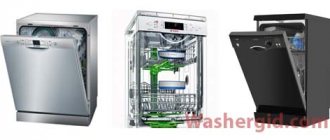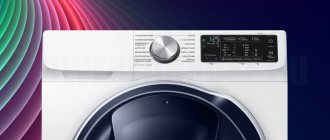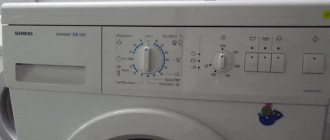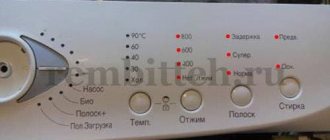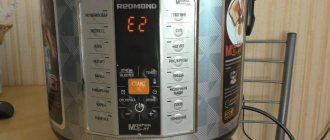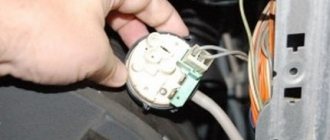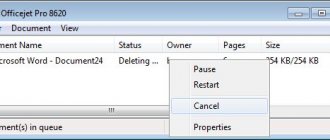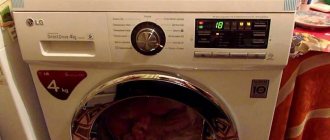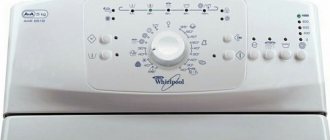Fixing error e4 in the dishwasher
How Samsung fault codes are deciphered
What malfunctions can be found in dishwashers? In the table below we have provided a breakdown of each code, and also suggested ways to troubleshoot the problem.
| Fault code | What does the error mean? | Reasons for appearance | What do we have to do |
| E1 | Long collection of water. | 1. Lack of water supply in the system. 2. The water supply tap is closed. 3. The inlet hose is clogged or pinched. 4. The door is not closed properly. 5. The filter mesh is clogged. | 1. Turn off the tap and check the presence of water in the water supply. 2. Turn the shut-off valve; it may have been closed. 3. Inspect the water intake hose. It should be level. Maybe he was bent over or pinched by some object. 4. Close the door more tightly. It is equipped with a locking lock. Until the lock locks the door, washing will not begin. 5. Clean the mesh filter. It is located at the junction of the inlet hose with the PMM body. Turn off the water, unscrew the hose and rinse the mesh. |
| E2 | What does the error code mean: the machine does not drain the water after washing dishes. | 1. Problems with the drain hose. 2. The filter is clogged. 3. The drain system is clogged. 4. The drain pump in the car is clogged. | How to fix the problem: 1. Inspect the drain hose that connects the dishwasher to the drain. If it is pinched or twisted, the water will not drain. 2. The filter located at the bottom becomes clogged with food debris. For normal drainage, clean the filter. But first, press the “Drain” button. 3. To check the drain hose for clogs, disconnect the end from the drain and place it in a bowl. If the drain does not occur, then you need to remove the hose and clean it of food debris and dirt. 4. If the drain pump is clogged, you can clean it yourself if you are familiar with the design of the dishwasher. But it's better to call a specialist. |
| E3 | No water heating. | 1. The heating element of the machine is faulty. 2. The thermostat is broken. 3. The control module has failed. | Self-repair if an error is detected: 1. Check that communications are connected correctly. If the car is new, you may have mixed up the hoses. 2. Check the set mode. If a delicate wash is set, the heating temperature will not exceed 40 degrees. 3. Inspect the Samsung dishwasher filter for clogs. When the water circulation is reduced, the heating element does not turn on. 4. Inspect the heating element. If it is overgrown with scale, it means the element needs cleaning. If the heater burns out, it will need a complete replacement. 5. Install a new thermostat if it is faulty. 6. Only a specialist can find out the cause of module failure and replace it. |
| E4 | The meaning of the code on a Samsung dishwasher is: too much water in the tank. | 1. The sensor that monitors the water level in the tank is faulty. 2. Problems with the water intake valve. | How to help: 1. Check the level sensor and replace it if faulty. 2. Inspect the intake valve. Replace if necessary. |
| E5 | Water pressure too low. | 1. Problems with the level sensor. 2. The dishwasher filter is clogged. 3. Clogged or kinked inlet hose. | 1. Inspect the level sensor. In case of breakdown, the sensor needs to be replaced. 2. Clean the filter from blockages. 3. Check the inlet hose. Adjust its location. |
| E6-E7 | Problems with the temperature sensor. | The thermostat does not work, water heating does not start. | A new temperature sensor needs to be installed. |
| E8 | The alternative valve has failed. | If after inspection a breakdown is detected, the valve is replaced. | |
| E9 | The program launch button does not work. | 1. Detergent got into the connectors of the button and it became stuck. 2. During operation, the button was pressed through. 3. There is a short circuit in the contacts leading to the button. | The panel with the button needs to be disassembled and cleaned. Check the button contacts; if they are burnt, they need to be replaced. |
| U.C. | Incorrect mains voltage. | If the voltage in the network is too low or too high, the dishwasher will not work, displaying an error. You can wait until the voltage returns, or call an electrician. | |
| EA | The water level in the dishwasher is too high. | 1. Problems with the drain hose. 2. Incorrect level sensor data. | 1. Inspect the drain hose. If it is pinched or clogged, water will not drain well from the machine. You need to clear the hose from blockages. 2. Check the serviceability of the water sensor. Replace if necessary. |
| 3E2 | There is no signal from the tachometer. | You need to check the wiring connections between the engine and the tachometer. | |
| Die | The door is not closed tightly. | Press the car door firmly, otherwise the wash will not start. | |
| Le | There was a water leak. | It is necessary to inspect the dishwasher body, determine and eliminate the cause of the leak. |
Before you start troubleshooting, unplug your Samsung dishwasher and turn off the water supply.
If the error appears on the screen for the first time, it is important to know how to restart the PMM. Rebooting is carried out by disconnecting the machine from the network for 15-20 minutes. If after turning on the error appears on the screen again, you need to look for the problem.
If you do not understand the dishwasher, entrust the repair to a specialist. It’s easy to damage parts, but restoring them can take a long time.
Decoding the code
Error code e4 in a dishwasher means “too much water.” This may mean that one of the pipes is leaking, or the plug on the inlet hose has become unusable, which is why liquid has accumulated in the tank with a volume exceeding the permissible norm. You can repair this fault with the help of a specialist or with your own hands. However, the services of a specialist are expensive - about 8 thousand rubles, so it will be easier to do the repairs yourself.
When error e4 occurs, the aquastop emergency system is activated. This means that the pan is full, and now it’s impossible to do without at least the initial draining of all the stagnant and non-flowing water. This is an initial measure and in order to understand how to fix error e4 in a dishwasher, you will first need to disassemble it and repair the broken parts. Next, we will look at the possible causes of leaks inside the machine and ways to eliminate them.
Possible causes of leaks inside the dishwasher
It is difficult to understand the reasons for the error without opening the housing and checking the sockets, pump and other elements of the drainage system. However, here it is necessary to mention the most common of them:
- Hose coming off the pump
- Leaking drainage system pipes
- Pump malfunctions
When is it necessary to contact specialists?
So, often a combination of light signals appears on the dishwasher panel - when the fine filter is clogged. You can try to figure it out yourself, at home. You will need to open the filter unit, disassemble, wash and put the removed parts back. This procedure is not final, because after its completion, you may again see the error on the display, then you should resort to the services of a professional adjuster.
A modern kitchen machine is capable of independently diagnosing its performance, showing and immediately notifying its owner. Each specific case must be approached individually, with the help of a specialist, and a number of errors can be eliminated yourself, at home.
Having dealt with the malfunction in the form of error E03, we can conclude that such an error cannot be seen during normal operation. Its appearance occurs during test run mode and indicates heating problems. To avoid a signal on the e3 indicator display, it is enough to clean the filters as necessary, at least once a month.
Be careful when starting the dishwasher for the first time and subsequent times, treat the equipment carefully and with care, and it will serve for a long time without malfunctions.
Source of the article: https://technosova.ru/dlja-chistoty-i-porjadka/posudomoechnaja-mashina/oshibka-e03/
Error E3 in a Krona dishwasher - how to fix it, Error code e3 in a dishwasher.
A few words about diagnostics
It should be explained how error codes are correctly recognized. The fact is that even service center technicians are sometimes dissatisfied with the self-diagnosis system developed by Samsung. They say that the dishwasher does not indicate a problem with its signal, but only creates some confusion.
In fact, you need to know the general principles of how to use decoding and what to pay attention to first in order to understand what the problem is the first time.
First of all, a general rule: when any code is displayed, a failure of the module responsible for general control can never be ruled out. The repair specialist must always remember this, and when checking the root causes does not yield anything, he should move on to secondary causes, the main one of which will be a malfunction of the module.
When an error code indicates a specific element (for example, a pump), it is recommended to check not only it, but also the wiring that goes with it and the bus on the control board, which is responsible for proper operation.
Deciphering error codes is considered the initial action, but troubleshooting should be approached comprehensively in order to achieve a positive result.
Error codes for Samsung washing machines with display
What appears on the display
Error code
What does an error mean?
Why did the error appear?
How to resolve the error
| 5E | Water does not drain from the machine. | The drain hose is clogged; Blockage in the sewer; The hoses inside the machine are clogged; The drain pump filter (drain filter) is clogged; The drain hose is bent or squashed; The drain pump does not work; The water in the car froze (the car was stored at sub-zero temperatures). | Instructions |
| 5C | |||
| E2 | |||
| H1 H2 HE HE1 HE2 | The water does not heat up. | The machine was incorrectly connected to the electrical network; The washing heater (heating element) does not work; The drying heater (heater) does not work. | Instructions |
| HC HC1 HC2 | |||
| E5 | |||
| E6 | |||
| 4E | Water does not fill into the car. | The water supply tap for the car is closed or there is no water in the house; The inlet hose is bent or squashed; The filler strainer is clogged; The “Aqua Stop” protection for the inlet hose has activated. | Instructions |
| 4C | |||
| E1 | |||
| 4C2 | Hot water is poured into the machine - above 50 °C. | The inlet hose is connected to the hot water tap. | Instructions |
| SUD | There is too much foam in the tank. | Put too much powder; They put in a powder that is not suitable for the automatic machine; They put in low-quality or fake powder. | Instructions |
| 5D (SD) | |||
| UE | The machine cannot distribute the items evenly in the drum. | The laundry is bunched up or twisted together; There are few things in the car: one or two; There is too much laundry in the car. | Instructions |
| UB | |||
| E4 | |||
| L.E. | Water drains from the machine spontaneously. | The drain hose is low; The drain hose is not connected correctly to the sewer; There is a hole or crack in the tank from which water is leaking. | Instructions |
| L.C. | |||
| E9 | |||
| 3E 3E1 3E2 3E3 3E4 | The motor is overloaded, blocked by a foreign object, or broken. | Overload of the electric motor due to a large amount of laundry; The electric motor does not work. | Instructions |
| 3C 3C1 3C2 3C3 3C4 | |||
| E.A. | |||
| U.C. | Unstable voltage in the electrical network (too low or high). | The machine is supplied with voltage less than 200 +/- 4 Volts, or greater than 250 +/- 4 Volts for more than 30 seconds. | Instructions |
| 9C | |||
| DE DE1 DE2 | The hatch door is not closed. | The hatch door is not tightly closed; The hatch door closing mechanism does not work. | Instructions |
| DC DC1 DC2 | |||
| ED | |||
| DC3 | The “Add Door” door (for additional loading of laundry during the washing process) is not closed or does not open. | The “Add Door” was not closed before starting the wash; The “Add Door” door lock/unlock does not work. | Instructions |
| DDC | The “Add Door” (for additional loading of laundry) was opened incorrectly during washing. | The “Add Door” was opened during washing without pressing the “Start/Pause” button. | Instructions |
| LE1 | Water got into the bottom of the car. | The drain filter is leaking (not tightly closed or damaged); Water leaks from the powder hopper (container); Internal connecting hoses or drain hose are leaking; Water is leaking from the door (the cuff is damaged). | Call support or register a repair request through the Online Service. |
| LC1 | |||
| TE TE1 TE2 TE3 | There is no signal from the temperature sensor. | The sensor or its wiring is damaged. | Instructions |
| TC TC1 TC2 TC3 TC4 | |||
| E.C. | |||
| 0E | There is too much water in the car. | The drain hose is not connected correctly to the sewer; The water fill valve is blocked in the open position. | Instructions |
| 0F | |||
| 0C | |||
| E3 | |||
| 1E | There is no signal from the water level sensor. | The sensor or its wiring is damaged. | Instructions |
| 1C | |||
| E7 | |||
| BE BE1 BE2 BE3 | The buttons/button on the control panel do not work. | The plastic buttons on the control panel become stuck (“stick”). | Instructions |
| BC2 | |||
| E.B. | |||
| A.E. | Communication error. | There is no signal between the control boards. | Instructions |
| A.C. | |||
| AC6 | |||
| C.E. | The water temperature before draining is greater than or equal to 55 °C. | The inlet hose is connected to the hot water tap. | If the inlet hose is connected to the cold water tap, then call customer service or register a repair request through the Online Service. |
| A.C. | |||
| AC6 | |||
| 8E 8E1 | The “VRT+” vibration sensor does not work. | The sensor or its wiring is damaged. | Call support or register a repair request through the Online Service. |
| 8C 8C1 | |||
| E.E. | The drying temperature sensor does not work (appears only on machines with a clothes drying function). | The sensor or its wiring is damaged. | Call support or register a repair request through the Online Service. |
| F.E. | The drying fan/hair dryer does not work (appears only on machines with a clothes drying function). | The dryer fan/hair dryer does not work. | Call support or register a repair request through the Online Service. |
| F.C. | |||
| SDC | The automatic dispenser does not work (appears only on machines with the Wi-Fi function). | The automatic dispenser does not work. | Call support or register a repair request through the Online Service. |
| 6C | The drive or wiring of the automatic dispenser is faulty (appears only on machines with the Wi-Fi function). | The automatic dispenser drive or wiring is not working. | Call support or register a repair request through the Online Service. |
| 2H | Remaining time until the end of the wash. | More than 99 minutes before the end of the wash (2H - 2 hours, 3H - 3 hours, etc.). | Instructions |
| 3H | |||
| 4H | |||
| Hot | High temperature inside the drum (appears only on machines with a clothes drying function). | The temperature inside the drum is above 70 °C. | Do not turn off the washing machine. Wait until the drum temperature drops and the “Hot” message disappears. |
| A0…A9 B0 C0 D0 E0 | Factory test mode enabled. | Factory test mode enabled. | Instructions |
| PoF | The electricity was turned off during washing (the error appears after the electricity is supplied). | The electricity went out while washing. | Press the Start/Pause button to continue washing. If you want to start the wash from the beginning, turn off the machine with the ON/OFF button and start the wash again. |
| B.C. | The car cannot start the engine. | The triac (triac) for turning on the motor rotation does not work. | Call support or register a repair request through the Online Service. |
Why does PMM Krona give an error?
The self-diagnosis system detects a problem with the dishwasher and then displays error code E3. The malfunction icons in the Krona instructions mean: prolonged heating of water to the set temperature. Possible causes are also indicated:
- Incorrect operation of the temperature sensor.
- Heating element malfunction.
Problems with the heating element are also indicated by malfunctions E6, E7.
It seems that the cause of the breakdown is serious and the parts will have to be checked and replaced. This is not the case here. Code E3 indicates not only heating problems, but also a clogged drain filter. It tells the user that it is time to clean the system.
Errors 0E, 0F, 0C, E3 on a Samsung washing machine
What's happened
The washing machine display showed an error message “0E”,
"0F"
"0C"
or "E3".
In models without a display, the indicators for all washing modes + two lower temperature indicators light up.
What does an error mean?
There is too much water in the car.
Why did the error appear?
● The drain hose is not connected correctly to the sewer;
● The water fill valve is blocked in the open position.
What to do next
Unplug the machine. 2 Disconnect the drain hose from the sewer (siphon, pipe). If you extended the drain hose, remove the part that was extended. 3 Place the end of the drain hose into the bathtub or sink. 4 Turn on the machine and run the same wash cycle.
Do not wait for an error to appear if the machine has filled a full drum of water. Stop the wash by pressing the Start/Pause button and submit a repair request.
If the error does not appear, it means the drain hose was connected incorrectly. To ensure that the machine operates without errors, properly connect the drain hose to the drain.
The sound of water pouring is heard
If you hear the sound of water filling, but the machine still gives an error, then:
- or there is too much laundry in the machine for the selected washing mode,
Information on the maximum load of laundry for each washing mode is indicated in the user manual, section “Operation” or “Instructions for washing laundry”.
- or things that are loaded into the drum absorb a lot of water: pillows, blankets, etc.
For washing, a certain amount of water is poured into the machine. If things absorb more water than planned, the level in the machine will decrease. The sensor will detect this and the machine will show an error.
If there are not many things loaded and there are no things that absorb a lot of water, then check the water pressure through the inlet hose. If the pressure is weak, an error will appear. In this case, contact a plumber.
I can't hear the sound of water pouring
If, after starting the wash, you do not hear the sound of water filling, and the machine shows an error, then:
- Make sure the water supply tap to the washing machine is open.
- Make sure there is cold water in the house. To do this, open the cold water tap. If there is no water or the pressure is weak, contact a plumber. The washing machine will not be able to start washing without water.
- If the tap is open and there is water in the house, check the water pressure through the inlet hose.
- If the pressure is strong:
A. Remove and clean the filler strainer.
B. Make sure the drain hose is connected correctly: it should come out of the machine and go straight down. If the hose is not positioned correctly, water will drain from the machine and it will show an error.
ON THIS TOPIC:
How to properly connect the drain hose
C. Unplug the machine for 15 minutes to reset the control unit.
D. Plug in the machine and run the same wash cycle.
E. If the error does not appear, continue to use the machine, everything is fine with it. If the error appears again, contact support.
If the pressure is weak:
Contact a plumber. The washing machine will not be able to start washing with low water pressure.
If there is no pressure:
A. Unscrew the other end of the hose from the water pipe and try to pour water into it.
B. If water is coming through the hose, have a plumber check the water supply valve and water pipe. If water does not pass through the hose, it is clogged. Buy a new hose or wash it with a strong stream of water.
Signal meaning
We proceed directly to deciphering the readings of self-diagnosis of a Samsung dishwasher. We list the codes, probable defects that provoked a particular signal, and the main actions aimed at eliminating the problem:
- E1 - using this code, the Samsung machine reports that water intake has been taking too long. The reasons may be hidden in turning off the water supply, the appearance of blockages or squeezing of the water intake hose, or a clogged filter installed in the inlet valve. To fix the problem, you will have to check the presence of water in the water supply system and the condition of the hose. In addition, the valve filter is cleaned;
- E2 - signal indicates that there are difficulties in removing dirty liquid. There is a suspicion that a blockage has formed in the water drainage hose, or it has been pinched somewhere. It is possible that debris has accumulated in the filter or in the nozzle; it is possible that the pump may break down. First of all, all water is forcibly removed from the Samsung dishwasher, after which all of the listed elements are checked one by one. It is more likely that the problem is hidden in the blockage;
- E3 – the water for washing dishes does not heat up. The water heating element is responsible for this function and should be checked first. After that, we move on to the thermostat, then check the wires and the modular bus. It is possible to perform such actions by first removing the side panel of the Samsung dishwasher;
- E4 - the circulation system is overfilled. Water can fill the machine with excess if the water intake valve does not close. The reasons are hidden in the pressure switch or electronic module. First, the valve is checked, then the remaining elements. Those that fail are replaced with new analogues;
- E5 - error code indicates that the water pressure in the machine is not strong enough. The problem may be explained by a breakdown of the pressure switch, which does not control the liquid level and does not send a signal to the water intake valve. It is possible that the valve or hose itself is clogged. Another version is low pressure in the central water supply network. We check the valve and hose for water intake, after which we diagnose the pressure switch, focusing on the electrical part of the relay;
- E6 and E7 - this pair of codes has the same interpretation, explaining problems with the temperature of the water. The dishwasher simply does not heat the liquid, and many consumers are beginning to attribute the problem to a failure of the heating element. In fact, you just need to inspect and replace the temperature sensor;
- E8 - the code indicates that the valve distributing water flows has failed. To eliminate the breakdown, you need to remove the right panel of the Samsung dishwasher, find the indicated element, check its resistance value and, if necessary, replace it;
- E9 - with this error code the machine reports a defect in the button that activates the machine’s programs. The main reasons are short circuit or wear of the contact group. It is necessary to disassemble the control panel to inspect and clean the contacts. There is a possibility that they will need to be completely replaced;
- EA - an error indicates a violation of the water level in the dishwasher. There was probably a failure in the pressure switch. As a rule, the problem is related to the sensor tube, or the element itself is not positioned correctly. The pressure switch is checked, cleaned, and set correctly.
Errors H1, H2, HE, HE1, HE2, HC, HC1, HC2, E5, E6 Samsung washing machine
What's happened
The washing machine display showed an error message H1, H2, HE, HE1, HE2,
HC, HC1, HC2,
E5,
or E6.
In models without a display, the indicators of all washing modes + the bottom and second temperature indicator from above light up
or indicators of all washing modes + two central temperature indicators.
Do not confuse with the 2H, 3H or 4H indication - this is the time until the end of the wash.
When the error appears
The error appears if you select a washing temperature of 40°C or higher. If you select a lower temperature, the error will not appear.
Why did the error appear?
There are several reasons:
- Unstable voltage in the electrical network;
- The machine was incorrectly connected to the electrical network;
- The washing heater (heating element) does not work;
- The drying heater (heater) does not work.
Signal meaning
We proceed directly to deciphering the readings of self-diagnosis of a Samsung dishwasher. We list the codes, probable defects that provoked a particular signal, and the main actions aimed at eliminating the problem:
- E1 - using this code, the Samsung machine reports that water intake has been taking too long. The reasons may be hidden in turning off the water supply, the appearance of blockages or squeezing of the water intake hose, or a clogged filter installed in the inlet valve. To fix the problem, you will have to check the presence of water in the water supply system and the condition of the hose. In addition, the valve filter is cleaned;
- E2 - signal indicates that there are difficulties in removing dirty liquid. There is a suspicion that a blockage has formed in the water drainage hose, or it has been pinched somewhere. It is possible that debris has accumulated in the filter or in the nozzle; it is possible that the pump may break down. First of all, all water is forcibly removed from the Samsung dishwasher, after which all of the listed elements are checked one by one. It is more likely that the problem is hidden in the blockage;
- E3 – the water for washing dishes does not heat up. The water heating element is responsible for this function and should be checked first. After that, we move on to the thermostat, then check the wires and the modular bus. It is possible to perform such actions by first removing the side panel of the Samsung dishwasher;
- E4 - the circulation system is overfilled. Water can fill the machine with excess if the water intake valve does not close. The reasons are hidden in the pressure switch or electronic module. First, the valve is checked, then the remaining elements. Those that fail are replaced with new analogues;
- E5 - error code indicates that the water pressure in the machine is not strong enough. The problem may be explained by a breakdown of the pressure switch, which does not control the liquid level and does not send a signal to the water intake valve. It is possible that the valve or hose itself is clogged. Another version is low pressure in the central water supply network. We check the valve and hose for water intake, after which we diagnose the pressure switch, focusing on the electrical part of the relay;
- E6 and E7 - this pair of codes has the same interpretation, explaining problems with the temperature of the water. The dishwasher simply does not heat the liquid, and many consumers are beginning to attribute the problem to a failure of the heating element. In fact, you just need to inspect and replace the temperature sensor;
- E8 - the code indicates that the valve distributing water flows has failed. To eliminate the breakdown, you need to remove the right panel of the Samsung dishwasher, find the indicated element, check its resistance value and, if necessary, replace it;
- E9 - with this error code the machine reports a defect in the button that activates the machine’s programs. The main reasons are short circuit or wear of the contact group. It is necessary to disassemble the control panel to inspect and clean the contacts. There is a possibility that they will need to be completely replaced;
- EA - an error indicates a violation of the water level in the dishwasher. There was probably a failure in the pressure switch. As a rule, the problem is related to the sensor tube, or the element itself is not positioned correctly. The pressure switch is checked, cleaned, and set correctly.
